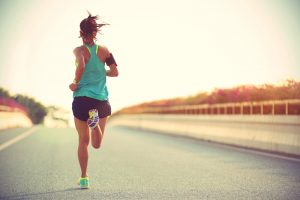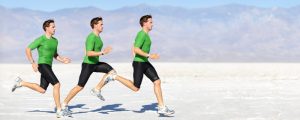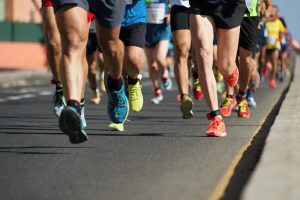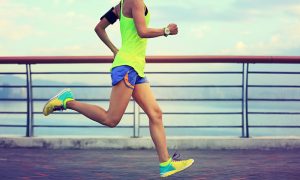
Runners, runners, runners… they are everywhere! I myself took the winter off running and am now finding myself pounding the gravel every other day. Ouf. Running is an incredible activity. Great stimulation for the heart, lungs and the muscles… it’s a great excuse to get outside… and all you need to do it pop on a pair of shoes and go! Right? Not exactly.
For all the positive simulation running places on the muscles and joints, there are negative aspects too It’s hard for many of to run efficiently, symmetrically and in a way that minimizes injury due to over use or faulty mechanics. Improving your form in even subtle ways is not only easier on the body it ultimately makes the running feel easier too.
The tricky variable for me here, is all of you are different. You each have unique running mechanics determined by how your body is built, including the current strength and mobility of your different joints and muscles.
That said, there are a few “tweaks” I can offer which may improve your running mechanics and lessen the negative load on your muscles and joints. The pre run tweaks are easy enough to add in. Try them out, and see if your runs feels any different. For the “during the run tweaks”, try applying each one during one minute of running. That is, run “normally” and then try to alter your mechanics with one technique for one minute. How did it feel? If it felt “better”, “more natural”, more comfortable” you may have a winning tweak. If it didn’t… try again with 2 or 3 more intervals. Still not jiving? Maybe it’s not what you need today. Move to the next tweak. But keep this other tweak in your back pocket. It may work another time.
Hips & Butt:
Open up your hips.
Strengthen your bum.
My two favourite exercise to do pre-run? Hip flexor mobility followed by hip bridges:

Cadence:
Efficient, fast, long distance runners tend to have cadences over 180 steps per minute (spm). Irrespective of what YOUR stride rate is, subtle increases in step rate can substantially reduce the loading to hips and knees and may prevent running related injuries.
On your next run wear a watch. Warm up 5-8 minutes. Count the number of foot falls in a given minute (or count the number of times your left foot hits the ground and multiply by 2!). Do this 3-4 times to get a solid average. Your goal for your more efficient strike rate should only be 5-8% higher. So if your current spm is 160, a goal of 168 is perfect.
So how do we do this?
- Alternate 1 minute faster turnover with 1 minute normal foot fall. Gradually increase the time spent at the higher spm.
- You can download a free metronome and set it to 168 bpm. Use this to help you pace the faster turnover intervals.
- Shorten the amount of time your feet contact the ground
- Think “run light”. You will likely find your core more engaged as your body tries to stabilize your legs and lessen their impact on the ground.
- The slightly faster cadence work will initially feel harder. You will likely become tired faster. It will take time for your core, hips and glutes to adjust to the new mechanical load. But ultimately, your running will become more efficient! And you will be less prone to injury.
- Simply thinking about engaging your abs, especially as you start to drive each thigh forward may help too.

Feet:
Dare I say this?: There is no right or wrong way for your feet to hit the ground. Again, everyone is built in a unique way. That said, there is evidence to show that mid-foot strikers tend to contact with ground almost directly under their center of mass. And heel strikers tend strike too far ahead of their center of mass, wasting precious energy “braking” and often landing with the knee locked out. In other words, I’m suggesting it may be more important to focus on trying to shift your foot strike so you’re striking under your center of mass rather than worry about what part of your foot is striking the ground first.
One of the easiest ways to shift your foot strike so it’s more under you, is by increasing your cadence. See point one 😊
There’s also evidence to suggest you can improve foot strike placement by:
- Increasing your hip mobility
- Strengthening your glutes
- And tweaking your running posture so your head is stacked over your shoulders which are stacked on top of your hips…

Tango:
Yes. Dance when you run. Not only does “tango-ing” help some runners naturally pick up their cadence, it also encourages more symmetrical and centered running. Which in turn lends itself to more efficient and safe pavement pounding.
It’s quite simple. As you run, rather than think “one, two, one, two, one, two…” as each foot hits the ground (left, right, left, right…) you think “one, two, three, one, two three…” The “one” or natural down beat, is now falling on alternate feet. You may tend to breathe out and brace on alternate foot falls, so that both hips get the advantage of a little more core stability as that foot hits the ground.
Head:
When I spoke about foot strike position, I mentioned the importance of trying to strike under your center of gravity. Well, that’s a lot easier to do if the rest of your body is nicely “stacked”.
Let’s start with the head:
Your head is heavy. And when it slides forward (think “text-neck”) it gets even heavier. Your neck and upper back will have to strain to hold it up. And you curve ever so slightly beyond your center of gravity. So hold your head right above your neck. Keep your gaze about 20 meters in front of you. Even try imagining you have a toilet plunger on the top of your head and someone is gently pulling up!
Shoulders:
Relax them. Keep them loose as well as low and back. This is where they are “meant” to sit, so despite being relaxed you’ll actually get better stability from them. AND in this position, they will help keep you centered.

Hands and Arms:
Relax your hands. This will help keep your shoulders and neck relaxed. Ok, don’t let them flop around… but “soften” them. You know what I mean.
Bend your elbows and about 90 degrees and swing them forward and back. Naturally pivoting from that beautifully stable and relaxed shoulder!
Core:
There’s no question a strong core improves running speed and posture. Running with your pelvis in a slight anterior tilt (think slightly distended belly) will inhibit your abs from firing effectively and may force your hamstrings to work harder to whip your legs forward. Keeping your pelvis in a more neutral position, for one mechanically “stacks” your pelvis right under your head and shoulders. It also makes it easier to activate your abdominals to help drive your thigh forward, and stabilize the hips so each foot fall can be lighter.
Below we’re outlined a simple interval workout. Do your best to relax your mechanics (and your brain!) during the easy intervals, and focus on different tweaks during the hard intervals. While this may sound counter intuitive, running hard (when you’re fresh… if you’re becoming fatigued everything falls apart…) tends to engage more muscular engagement. Especially through the core as your exhale become more forceful. This can make it easier to run centered under your mass. Also, running faster will often increase your cadence a bit naturally. You’re naturally a bit quicker to pick those feet up.
Important to note: Please try to use RPE as your gauge for “HARD” vs speed. Your “Fast” or “HARD” pace is a 8 or 9 out of 10. “EASY” pace should feel like a 3 or 4 once you settle in and your heart rate recovers. Making changes to your natural stride, however subtle, can make the running feel harder at first. This is especially true when you first work on increasing your cadence.
Warm-up 1: Hip flexor mobility and 10-16 hip bridges (see Hips & Butt from Thursday’s Post)
Warm-up 2: 4-7 minutes easy running
FAST pace : EASY pace
1:1
2:2
3:3
Walk for 1 minute
Repeat 2-4 times
Cool down 5 minutes.

